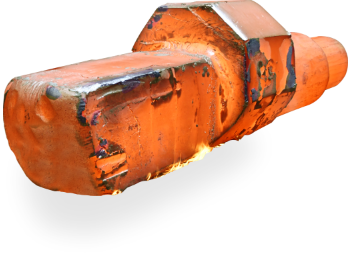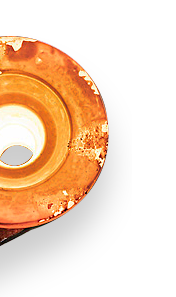
Advantages of Converting Casting to Forgings

Why Forging Over Other Methods?
Everyday economic and competitive threats, along with part failures, warranty issues and reputational impact drive manufacturing decision magkers to seek metalworking alternatives.
SCOT FORGE EVALUATES CONVERSIONS ON A CASE-BY-CASE BASIS.
We consider various factors, including the ability to redesign a product as well as the design requirements for the end-use application. Often, this requires engineers to challenge traditional methods and consider new technological advances.
CASTING CONVERSIONS CAN FREQUENTLY LOWER TOTAL COSTS.
Forgings usually target a lower total cost when compared to a casting or fabrication. When we evaluate cost factors, such as product life-cycle costs from procurement, lead time and rework, as well as costs of scrap, downtime and further quality issues and opportunity costs, the long-term benefits of forgings can far outweigh the short-term cost-savings of castings or fabrications.
Reducing manufacturing costs. Improving part performance. Minimizing material waste
The Scot Forge customer value engineering team brings the knowledge of custom forging experts to work in your plant, helping you to achieve long-term cost reductions, enhanced part performance and improved lead times through:
Near-net shape parts not previously available
Component reduction - weldment elimination
Optimizing your specifications and manufacturing practices
Computer simulations to design parts to take advantage of forged properties
Customizing alloy development and thermal treatments for your application
Optimizing your specifications and manufacturing practices
Consider Forgings
Forging is a viable solution to your problem if you find yourself in any of these situations:
Your component serves as a critical part of a product’s design
The current design continually causes issues from your customer’s perspective
You waste valuable time and materials on questionable castings
Significant warranty issues
Fast delivery and breakdown services
You could be working on other projects versus re-machining parts (i.e. opportunity cost)
The long lead times for the casting design result in downtime and lost revenue
You spend considerable time searching for casting patterns or manufacturers
You have design control over the end-use product

Possible Problems With Castings
Casting may be the best option for some applications, but when robustness in design is required many turn to forgings. From porosity to material inconsistencies, casting can cause more problems than solutions. But you can solve these problems by working with our employee-owners, we have advanced forging technology and the expertise to produce forgings for applications that require more complex shapes. Consider converting castings to forgings for stronger, more sound and technically superior components and a better supply-chain solution.

Having more than 125 years of metal forming experience, we can help you improve part performance and reduce costs. Discover what we can add to your project in the download below.

With every order we process, product we forge and quality test we conduct, our goal is to exceed customer expectations in every way possible.
We have a technically trained sales staff, as well as industry-specific specialists, who understand your market requirements. Each customer is valued and placed in the capable hands of a dedicated account manager who will see your order through from inquiry stage to order placement, expediting and shipping.
By cultivating a personal relationship with Scot Forge, you will find skilled resources to complement your own. Working together, our companies will create a lasting partnership—a partnership that is focused on getting you high-quality products, meeting your time constraints and helping your company be better prepared to go to market.
Forging Conversion Profit Improvement:
Construction equipment manufacturer
A customer’s product had a long history of issues due to poor casting quality. Working with Scot Forge, they were able to transition the casting to a forging which removed all re-work and weld repair from their process and allowed them to provide a better component to their customer. This saved an average of seven (7) processing hours per piece.
Defense contractor
Scot Forge collaborated with a customer to convert a 22 piece fabrication into a two (2) piece forging design, saving over 500 hours in welding costs per unit.
Mining equipment manufacturer
Our customer’s casting supplier was not able to meet their production demand due to significant weld repair issues, resulting in a potential loss of a significant amount business. Scot Forge was able to provide a solution that met the customer’s demand and delivery requirements at a lower total cost than the casting, saving money and defending business.
Forging Conversion Part Improvement:
Product/application
Rotor arm
Material
Alloy Steel
Previous processing problems
The previous process was a casting.
-
The cast part, because of its lack of directional grain flow, did not have the required strength for the demanding application.
-
Due to the lack of strength, part failures were occurring in the field, and the part had a short life span.
-
Costly repairs and maintenance were necessary because of the frequent failures.
Forging as the solution
Today the part is forged as a one-piece forging.
-
Forging provides a continuous grain flow which ensures high strength, integrity, and longevity.
-
The improved strength has minimized part failures, as well as the need for repair and maintenance.

Product/\application
Centrifuge bowl
Material
Stainless Steel
Previous processing problems
The part was previously centrifugally cast.
-
The customer required a stronger, more resilient centrifuge able to withstand heavy wear and tear, so production could be increased.
-
To manufacture a stronger centrifuge as a centrifugal casting, the RPMs would have to be increased, and the higher loading would have exceeded the attainable properties of the material.
-
The centrifugal casting tooling charge and process costs were expensive, and a stronger centrifuge required a more costly material.
Forging as the solution
Today the part is manufactured as a near net forging.
-
Forging permitted the design change to a stronger centrifuge, while maintaining the customer's original alloy choice.
-
The ability to handle increased service requirements due to a stronger centrifuge allowed the customer to increase production by 15%
-
The forging cost for the improved centrifuge was 24% lower than the original centrifugal casting.

Product/application
Hub for a steel mill rolling application
Material
Alloy Steel
Previous processing problems
The part was originally a casting
-
Casting failed to meet critical surface requirements, resulting in scrapped parts.
-
At times, inclusions were not found until after extensive finish machining.
Forging as the solution
Today the part is produced by forging.
-
The hub is now produced by forging and torch cutting.
-
The part has higher strength and structural integrity due to forging's continuous grain flow.
-
The use of cleaner, forging-quality material eliminated surface quality problems and rejections.

Make Scot Forge Your Forging Partner
The knowledge and experience of our engineers, metallurgists and forging experts work in collaboration with your team, helping you to achieve long-term success. Rather than dismissing the idea as impractical or impossible, call on us to help enlighten you and your team of the technical and/or economic merits of any particular conversion project. We will devote as many resources as needed to provide a thorough review and subsequent proposed solution to your casting or fabrication problems.
With the help of Scot Forge and Scot Forge’s creative engineering, Sloan Industries, Inc (Wood Dale, IL) discovered that using forging, rather than casting on magnesium die casting goosenecks yielded better machine performance and part quality.
Scot Forge worked with Deca Industries to create a highly unusual three-spoke forging. The forging replaced a casting used in the mining industry.
CTI Molecular Imaging (Knoxville, TN), in a joint effort with Scot Forge recently converting a cast component to a forging in the production of steel rings and hubs for its Eclipse Cyclotrons.

Scot Forge Difference
At Scot Forge, we know the importance of getting your parts on-time, as expected. However, for customers new to procuring forgings, ordering a forging that will meet all specifications for end-use applications may be a challenge, which is why finding a trusted supplier and partner is essential. Our employee-owners are here to ensure your project stays on track with our forgings by offering:
Quality Assurance
Scot Forge is proud to be ISO 9001:2015 and AS9100D certified, and our team is committed to providing outstanding customer satisfaction. Further pursuance of aerospace products has led to NADCAP accreditation in both Heat Treatment for nickel material and Nondestructive Testing.
Every Scot Forge customer gets placed with a qualified team that will guide each nickel forging delivered from the inquiry stage to order placement, expediting and shipping.
We offer many size forgings in both standard and unique geometries to meet your needs.








